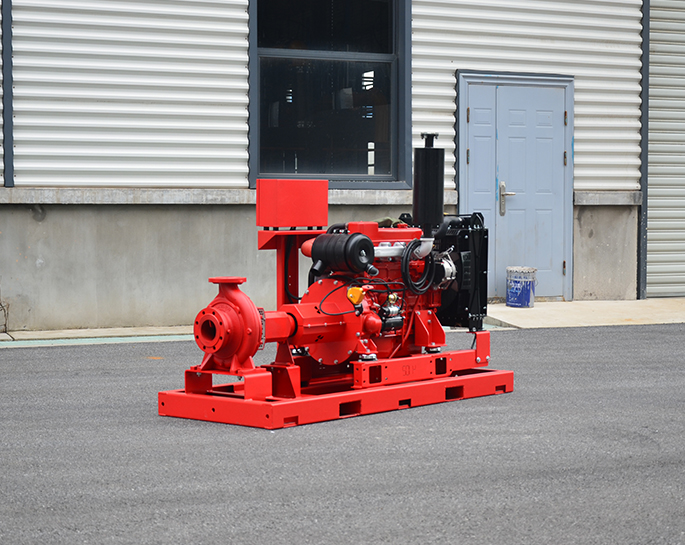How do you manage noise levels from fire pump operations?
Jun 06, 2024
Share:
Managing noise levels from fire pump operations is crucial for maintaining a comfortable environment in high-rise buildings, particularly in residential and mixed-use buildings where noise can impact the quality of life. Here are several strategies to manage and mitigate noise levels from fire pump operations:
1. **Location and Placement:**
- **Remote Location:** Place the fire pump room away from noise-sensitive areas, such as residential units or offices, ideally in the basement or a dedicated mechanical floor.
- **Isolated Room:** Ensure the pump room is isolated from the rest of the building with adequate distance and barriers.
2. **Room Design and Construction:**
- **Soundproofing:** Use soundproofing materials for the walls, ceiling, and floor of the pump room. This can include sound-absorbing panels, acoustic tiles, and insulation.
- **Double Walls:** Construct double walls with an air gap or sound-dampening material between them to reduce noise transmission.
- **Heavy Doors:** Install heavy, soundproof doors with proper seals to prevent noise leakage.
3. **Vibration Isolation:**
- **Mounting Systems:** Use vibration isolation mounts for the fire pump and associated equipment to prevent the transmission of vibrations to the building structure.
- **Flexible Connections:** Install flexible connections for piping and electrical conduits to minimize vibration transfer.
- **Base Isolation:** Use isolated bases or inertia bases for the pumps to further reduce vibration transmission.
4. **Acoustic Enclosures:**
- **Pump Enclosures:** Enclose the fire pump in an acoustic housing designed to absorb and contain noise.
- **Engine Silencers:** For diesel fire pumps, use exhaust silencers to reduce engine noise. Additionally, install intake and exhaust silencers for combustion air and cooling air systems.
5. **Operational Controls:**
- **Soft Starters:** Use soft starters or variable frequency drives (VFDs) to reduce the noise associated with the startup and operation of electric pumps.
- **Regular Maintenance:** Ensure regular maintenance of the fire pump and its components to avoid excessive noise from worn-out or malfunctioning parts.
6. **Building Design and Layout:**
- **Zoning:** Design the building layout to place less noise-sensitive areas, such as utility rooms or storage areas, adjacent to the fire pump room.
- **Buffer Spaces:** Create buffer spaces, such as corridors or storage rooms, between the fire pump room and occupied spaces.
7. **Noise Barriers:**
- **Acoustic Barriers:** Install acoustic barriers around the fire pump and associated equipment. These barriers can be made of dense materials that absorb and block sound waves.
- **Sound Absorbing Panels:** Use sound-absorbing panels on walls and ceilings within the pump room to reduce reverberation and noise levels.
8. **Consultation with Acoustic Engineers:**
- **Professional Advice:** Engage an acoustic engineer or consultant to assess the noise levels and recommend specific design modifications or noise control measures tailored to the building and pump system.
By implementing these strategies, noise levels from fire pump operations can be effectively managed, ensuring that the fire protection system does not negatively impact the building’s acoustic environment.

1. **Location and Placement:**
- **Remote Location:** Place the fire pump room away from noise-sensitive areas, such as residential units or offices, ideally in the basement or a dedicated mechanical floor.
- **Isolated Room:** Ensure the pump room is isolated from the rest of the building with adequate distance and barriers.
2. **Room Design and Construction:**
- **Soundproofing:** Use soundproofing materials for the walls, ceiling, and floor of the pump room. This can include sound-absorbing panels, acoustic tiles, and insulation.
- **Double Walls:** Construct double walls with an air gap or sound-dampening material between them to reduce noise transmission.
- **Heavy Doors:** Install heavy, soundproof doors with proper seals to prevent noise leakage.
3. **Vibration Isolation:**
- **Mounting Systems:** Use vibration isolation mounts for the fire pump and associated equipment to prevent the transmission of vibrations to the building structure.
- **Flexible Connections:** Install flexible connections for piping and electrical conduits to minimize vibration transfer.
- **Base Isolation:** Use isolated bases or inertia bases for the pumps to further reduce vibration transmission.
4. **Acoustic Enclosures:**
- **Pump Enclosures:** Enclose the fire pump in an acoustic housing designed to absorb and contain noise.
- **Engine Silencers:** For diesel fire pumps, use exhaust silencers to reduce engine noise. Additionally, install intake and exhaust silencers for combustion air and cooling air systems.
5. **Operational Controls:**
- **Soft Starters:** Use soft starters or variable frequency drives (VFDs) to reduce the noise associated with the startup and operation of electric pumps.
- **Regular Maintenance:** Ensure regular maintenance of the fire pump and its components to avoid excessive noise from worn-out or malfunctioning parts.
6. **Building Design and Layout:**
- **Zoning:** Design the building layout to place less noise-sensitive areas, such as utility rooms or storage areas, adjacent to the fire pump room.
- **Buffer Spaces:** Create buffer spaces, such as corridors or storage rooms, between the fire pump room and occupied spaces.
7. **Noise Barriers:**
- **Acoustic Barriers:** Install acoustic barriers around the fire pump and associated equipment. These barriers can be made of dense materials that absorb and block sound waves.
- **Sound Absorbing Panels:** Use sound-absorbing panels on walls and ceilings within the pump room to reduce reverberation and noise levels.
8. **Consultation with Acoustic Engineers:**
- **Professional Advice:** Engage an acoustic engineer or consultant to assess the noise levels and recommend specific design modifications or noise control measures tailored to the building and pump system.
By implementing these strategies, noise levels from fire pump operations can be effectively managed, ensuring that the fire protection system does not negatively impact the building’s acoustic environment.


.png)
.png)

.png)


